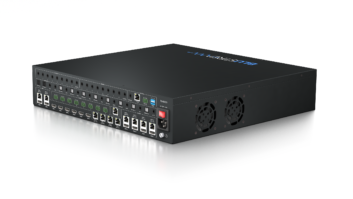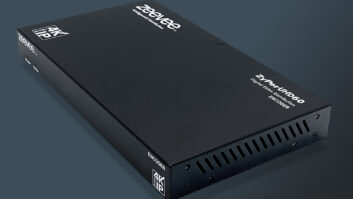Something remarkable occurred at the Integrated Systems Europe (ISE) show in Amsterdam this past February. After years of quietly simmering in the background, systems offering the ability to distribute Ultra HD video over IP suddenly burst onto the scene. Why? Thanks to recent advances in chipsets, processing, software, and user preferences, for the first time true 4K/60 4:4:4 HDR video over IP (UHD video over IP) were actually possible.
To be sure, for years now, systems from companies like Just Add Power and others have offered video over IP–typically HD video. But, generally, they have not found wide adoption with integrators, largely because these systems often relied on heavy compression with tradeoffs in quality, reliability, or latency. But now…everything has changed.

Clockwise from top left: TechLogix’s TL-IPFO 10G fiber solution, Savant’s Pro AV IP product, Purelink’s VIP 300H, and ZeeVee’s ZyPer4K.
Whether known as video over IP, AV over IP, 4K video over IP, or UHD video over IP, the category has been embraced by several companies, many of them having announced all-new systems at ISE, where a new industry technology group, called the Software-Defined Video over Ethernet Alliance (SDVoE), was born, as well.
The Impact on Matrix Systems
The successful adoption of these systems in the industry could have a dramatic influence on integrators’ businesses. It would almost certainly spell the end of the proprietary matrix solutions from the major control automation companies. How do they feel about this? Well, consider the fact that two of the companies making the biggest splash at ISE were Crestron with its Digital Media NVX UHD Video over IP 1Gigabit solution, and Savant with its new Savant Pro AV over IP 10Gigabit solution.
“This technology is superior to everything that’s out there, and so we’re competing with all of those, including ourselves,” said Savant’s director of product marketing, Tim McInerney. “We’re competing with our own existing chassis-based solutions, because this is better.”

John Clancy, VP of residential for Crestron, is equally bullish about the new technology, but said that his company’s transition to the new platform will be more gradual. “For the foreseeable future, we’ll exist with multiple platforms–based on the infrastructure and based on the cost,” he said “Although I already know that there are multiple versions of the NVX product coming that will have less features and be more cost effective.”
How Did We Get Here?
To achieve UHD video over IP, these systems utilize an encode/decode or transmit/receive process that is similar to HDBaseT. But, in this case, these systems utilize universal IP standards, rather than a proprietary system. What that means is that you place an encoder at your source, connected via HDMI, and it takes the video signal, converts it into data packets, and transfers it through your switch and across the Ethernet network to be decoded back to HDMI video at your display. All of this is done instantaneously with extremely low latency.
In addition to the technology, other influences were necessary to create momentum for these solutions. According to McInerney, there have been emerging standards and chipsets coming out from major chip manufacturers over the last two years that made the technology easier to implement. That development was combined with increased consumer demand for 4K during the holiday season and actual 4K content availability from DirecTV, DISH Network, Comcast, and Roku.

“At the same time you have 4K TVs coming down in price to a more reasonable level,” McInerney said. “The combination of chipsets, software, and standards for being able to do that stuff over IP simultaneously with very low latency are hitting at the same time that consumer demand and the price points for both the sources and endpoints are also coming there. So it’s kind of like the perfect storm for all of this to come together.”

Bob Michaels, CEO of ZeeVee, a leading provider of 10G solutions and a founding member of the SDVoE Alliance, believes that the advances in technology in IP over the past 20 years have led the industry to this point. “I think we’re really at that inflection point now,” he said, “where it’s not only capable and practical, [but] it’s the way the industry is going to move.”
Major Advantages of UHD Video over IP
Proponents of UHD video distribution over IP point to several advantages that their systems offer as compared to proprietary matrix-or chassis-based solutions from the major control automation brands.
The first advantage cited is the open-source nature of these systems; they all use standard Ethernet data networks, with both standard cables and switches. Ethernet and IP protocol are ubiquitous, well established, and continuing to grow and technologically advance. In many cases, clients can use existing networking equipment to upgrade to a video distribution system by simply adding transmit/receive boxes. Some systems require a third control box. Most matrix, chassis, and HDBaseT systems, on the other hand, use proprietary switches, cabling, and protocols, not to mention their own control programming. Commenting on the challenges associated with proprietary matrix solutions, Michaels said, “Then you have to depend on one company for all of this. And suddenly you have employees that hold you hostage because he’s the only guy in the entire company that’s Crestron certified, or AMX certified, or Control4, or whoever it might be. But with IP, now I can just use general knowledge. I mean IP is there.”
The second advantage noted is “flexibility.” With proprietary matrix solutions, you typically buy a matrix switch that matches the original plan of your installation, say a 16×16 unit with 16 inputs and 16 outputs. Clients, however, are notorious for walking up and saying, “Is it a problem to add another TV?”
“So if you have a 16×16 [matrix] switch and all of a sudden you get a thirty-third input, you have to rip it out,” Michaels said. “And if you have a configuration that’s 5×16, you have to buy a 16×16 matrix and spend money you shouldn’t have to spend.”
But with UHD video over IP, if your Ethernet switch runs out of ports, you simply daisy chain another switch that, when connected, acts as a singular large switch.

SDVoE president Justin Kennington noted that 10G switch prices have come down dramatically, so integrators can afford to spec in slightly larger switches for future expandability. Expansion then becomes simply a matter of adding transmitters/receivers as needed.
The third potential advantage is efficiency, according to the experts. In the existing world of high-end systems, integrators are installing two parallel networks–a data network for the client’s computers and smartphones and a separate AV system network based on a proprietary matrix system with its own cabling and protocol requirements.
In the case of UHD video over IP, many times there can simply be one system handling both the data network and the AV network. This is a more efficient setup and in many ways more logical to the end users.
At the basic level, companies are offering UHD video over IP for either 1G or 10G networks. There are, however, many differences between products, and each company offers unique benefits. At the risk of oversimplifying, here are some of the major differences of 1G versus 10G:
1 Gigabit Systems – Advantages
Retrofit-Friendy: Most residential network installations are based on 1G switches, and so this becomes an immediate advantage for UHD video over IP solutions based on 1G networks. Simply by accessing existing infrastructure in the home, assuming a good quality switch, an integrator can easily upgrade his client to Ultra High Definition video distribution throughout their home. This, however, depends somewhat on the level of use. If, for example, multiple simultaneous video streams are regularly required, then it may be prudent to run the 1G UHD video over IP system as a separate network from the existing data home network.

The power of a simple retrofit upgrade is not lost on Hagai Feiner, founder of network systems provider Access Networks.
“When I saw it [the Crestron DM NVX 1G UHD Video over IP model], I thought holy-moly, this is an awesome retrofit opportunity for us,” Feiner said. “And we see it as a good way to get back into that house, talk to the homeowner about Ultra High-Def, and also about upgrading their wireless, because no one has touched their network in five years.”
Feiner said that, as an industry, we have a choice. “What are we going to do? Are we going to continue and try and distribute HDMI in all kinds of [different] ways? Or are we going to take a format that is existing and that is ubiquitous [IP], and use that as a vessel to deliver content to our clients? I think it’s going to be the latter.”
Affordability: Another advantage to 1G systems is that they tend to be more affordable than their 10G colleagues, thanks in part to the lower cost of 1G consumer-level switches.

Purelink director of sales Howard Schilling made the point that some in the industry pursue ultimate specs that are illusory or pointless. That’s not the approach his “value-minded” company prefers to take. “We want to bring a one-class solution out that performs at a level that is expected and that is more than optimal for the vast majority of applications that it will be put in,” he said. “And most importantly, at a very reasonable price; it’s all about value to the end user.”
Performance: A hard truth is that the Ultra High-Definition video standard of 4K/60 4:4:4 HDR works out to 18Gb/s bandwidth. It takes some clever technology to fit 18Gb down a 1G pipeline. Typically, this means compressing the signal or taking other steps to fit the available bandwidth of the 1G network standard.
In the case of many 1G system providers, simple tradeoffs result in what is considered “visually lossless” performance. Purelink senior product manager Keith Frey explained how his company delivers 4K performance, with the best value, via its VIP-300H-U UHD video over IP system.
“The spec on the Ultra HD version of the VIP-300H-U is 4K/60 4:2:0 with HDCP 2.2 is also capable of 4K/30 4:4:4,” he said. “Our industry spends a lot of time chasing the bigger, better number–faster, deeper color, deeper bit depths, uncompressed, and so on. But what a lot of people don’t think about is what they’ve been looking at for years. The best-looking images they’ve ever seen have been compressed images of some sort. Ever since high definition took over some years ago, people have been watching broadcasts and Blu-ray players that have been doing 4:2:0 chroma subsampling. But you don’t hear anybody saying, ‘I’m not happy with that 4:2:0’–it’s better than anything they saw before, relatively.”
Crestron’s Clancy is enthusiastic about the company’s DM-NVX UHD video over IP product. “From our perspective, what our DMNVX product brings is, [our] collaboration with Intel,” he said. “Our intellectual property behind [the Intel chip] provides 4k/60 4:4:4 with HDR over a 1Gigabit network with zero latency when compared with any other streaming or distribution product that contains a scaler. If you looked at our traditional HDBaseT product and add a scaler to it, it adds between 20 and 30 milliseconds of latency. And that’s exactly what you get with this product.”
10 Gigabit Systems – Advantages
It’s a Total Solution: 10G systems, unlike 1G solutions, always offer the ability to use a single network solution. In the case of 1G systems, they may be a single solution to both the data and the entertainment networks, but that depends largely on how the clients use their system. In the case of 10G, there is more than enough horsepower and bandwidth to handle both responsibilities. In essence, the system includes a 1G data network and a 9G UHD video over IP distribution network–all in one.
Future Proofing: Companies offering 10G systems concede that there’s a premium cost associated with 10G. This is part of the reason why 10G systems have been mostly sold in commercial installations up until now. In commercial, budgets tend to be higher, they readily recognize the importance of a single solution for both data and video distribution, and–unlike the residential market–they often are already using 10G network infrastructure.
But 10G system makers counter that 1G systems are more highly compressed and are based on today’s standards, rather than tomorrow’s.
Savant’s McInerney put it this way: “If you’re installing one of these systems in your home, and you’re paying for a high-end system, well, geeze, don’t you want the best? Like, why are you putting in the system otherwise?”
Performance: Without a doubt, the single greatest argument for installing a 10G system is that it represents the best performance available today in an IP-based video distribution solution. The target market for a technology of this caliber is familiar to TechLogix, maker of their TL-IPFO 10G fiber solution.
“We’ve spent a lot of time going after the really high-end part of the market–the 4K/18G equipment–there’s not a lot of companies that can do that right now,” said Cameron Smith, founder of. TechLogix. “We were going for the performance play. We just see that 4K is where everything in the market is going. We know that 8K is coming very quickly…”

Many companies introduced all-new video-over-IP systems at ISE, where a new industry technology group, called the Software-Defined Video over Ethernet Alliance (SDVoE), made its debut.
The SDVoE Alliance, whose roster of founding members includes Aptovision, AQuantia, Christie, Sony, Netgear, and ZeeVee, along with contributing members DVI Gear, Grandbeing, and IDK, and adopting members Arista, Aurora, Cleerline SSF, HD CVT, TechLogix, and Xilinx, sees its industry role as making the technology “number one as a performance standard.”
One key to the enhanced performance of 10G systems comes from the simple fact that they only need to use, as Kennington said, “very, very light compression.” It is far easier to compress 18G to 10G than it is to compress 18G to 1G. When asked if 10G systems like those promoted by the SDVoE Alliance can compete with high-end matrix solutions, Kennington responded with an enthusiastic, “Absolutely yes! We can move all of the same formats that the matrix switch can move with identical latency performance and with identical image quality performance. In fact, very, very few matrix switch systems today–I think none that only use a single cable–can deliver full 4K/60 in all of the formats described in HDMI 2.0A. Whereas an SDVoE system can do that today. So, I would actually say that we outperform the vast majority of matrix switches and can match any of them.”
We’ll give the last word to ardent supporter of 10G systems, Savant’s McInerney: “I think everybody sees the same writing on the wall–that this is the wave of the future.”
A regular RS contributor, Ted Green publishes a widely read weekly CE business blog at strata-gee.com, the online home of The Stratecon Group, his marketing and strategy agency for the tech industry.







